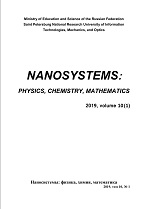|
CHEMISTRY AND MATERIAL SCIENCE
Investigation of sensing performance of silicene nanoribbon towards methanol and ethanol molecules: A computational study
Shazia Showketa, Khurshed A. Shahb, Ghulam N. Dara, Muzaffar Ali Andrabic
a Department of Physics, University of Kashmir, Srinagar,
J&K-190006, India
b Postgraduate Department of Physics, Sri Pratap College, Cluster University Srinagar, J&K-190001, India
c Department of Applied Sciences, Institute of Technology, University of Kashmir, Srinagar, J&K-190006, India
Abstract:
In this work, we perform an intricate computational analysis to investigate the adsorption mechanism of human breath exhaled VOCs, namely, methanol and ethanol, along with interfering water vapour on the surface of armchair silicene nanoribbon (ASiNR) by employing density functional theory to analyse the structural, electronic, and transport properties. The findings indicate that the most favorable adsorption configuration for methanol and ethanol involves the hydroxyl group (-OH) oriented towards the silicene surface, after optimisation. Moreover, we have calculated the adsorption energies which shows that ethanol is strongly physisorbed than methanol and water molecules on the ASiNR surface. Apart from that, the results of IV characteristics, transmission spectra and density of states corroborate these observations. In addition, we have computed the sensitivity (%), the results of which revealed that methanol demonstrates a high sensitivity of 42% compared to other molecules towards the surface of ASiNR. Furthermore, the recovery time of the sensor was found to be extremely long, which indicates that ASiNR based device has great potential for use as disposable sensors and scavengers for toxic gas molecules.
Keywords:
armchair silicene nanoribbon, DFT, volatile organic compounds, sensitivity.
Received: 05.01.2024
Revised: 21.02.2024
Accepted: 07.04.2024
Citation:
Shazia Showket, Khurshed A. Shah, Ghulam N. Dar, Muzaffar Ali Andrabi, “Investigation of sensing performance of silicene nanoribbon towards methanol and ethanol molecules: A computational study”, Nanosystems: Physics, Chemistry, Mathematics, 15:3 (2024), 418–428
Linking options:
https://www.mathnet.ru/eng/nano1285 https://www.mathnet.ru/eng/nano/v15/i3/p418
|

| Statistics & downloads: |
| Abstract page: | 27 | | Full-text PDF : | 20 |
|




 Contact us:
Contact us: Terms of Use
Terms of Use
 Registration to the website
Registration to the website Logotypes
Logotypes







 Citation in format
Citation in format 